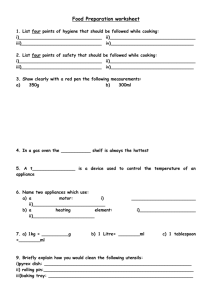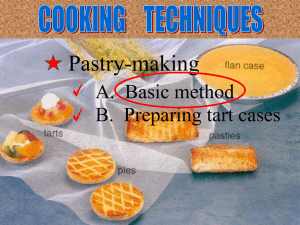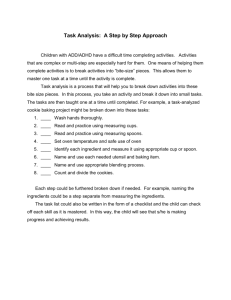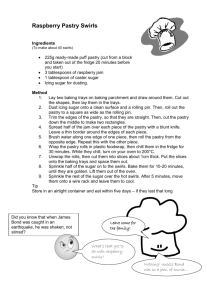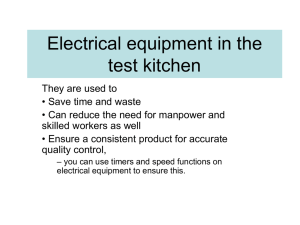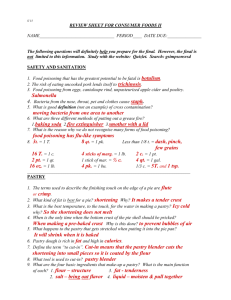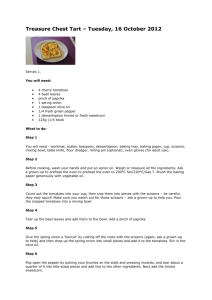Home Baking
advertisement
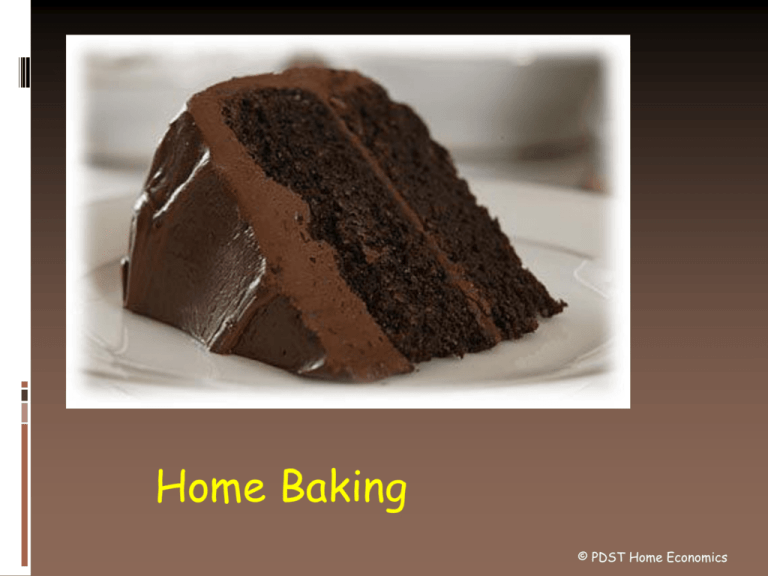
Home Baking © PDST Home Economics Advantages of Home Baking Better flavour Attractive appearance Cheaper No preservatives You can control ingredients Ingredients for baking Flour: usually wheat flour because it contains gluten Fat: keeps bread fresh, butter has the best flavour, margarine is economical Ingredients for baking Sugar: granulated or castor sugar can be used for sweetness, brown sugar adds a spicy flavour, icing sugar is used for decorating Eggs: should be fresh and at room temperature used to trap air Ingredients for baking Fruit: fresh or dried used to add flavour Liquid: water, milk, egg used to make dough Ingredients for baking Raising agent: makes product light and spongy, can be natural, chemical or biological Raising Agents Raising agents make bread and cakes rise in the oven so that they have a spongy texture Raising agents put a gas (air and/or CO2) in the mixture In the oven the heat makes the gas expand which pushes up the mixture The mixture is able to stretch because of the gluten in the flour After a while the heat in the oven sets the gluten so that the mixture keeps the risen shape Natural raising agent: Air Used alone in sponge cakes and pastry or with another raising agent in other baked goods. Air is put into mixtures by Sieving Rubbing fat into flour Creaming sugar and fat Whisking eggs with sugar (a) (b) (c) (d) Chemical Raising Agents These depend on a chemical reaction to make the gas in the dough. An alkali and an acid react to make a gas called carbon dioxide (CO2) Baking Powder + Milk = CO2 (Alkali + Acid ) + Moisture = Gas Bread Soda + Buttermilk = CO2 Alkali + (Acid + Moisture) = CO2 Biological Raising Agent Yeast Tiny living organisms make CO2 in the dough In the oven the bubbles of CO2 expand and pushes up the dough, until the gluten sets the dough The heat also kills the cells Oven temperature Pre-heat oven to correct temperature Too hot – outside burns inside still raw Too cool – gas escapes – bread doesn’t rise Rules for Home Baking Prepare tins and oven shelves in advance. Pre-heat oven. Use fresh ingredients. Weigh and follow recipe carefully. Sieve to add air. Add liquid carefully. Handle as little as possible, knead lightly. Once wet put in oven a.s.a.p. Time carefully, avoid opening door. Test for doneness. Cool on wire tray. Methods of baking Method The rub-in method. Used for Scones, Fat rubbed into flour. yeast bread, pastry The creaming method. Queen cakes Fat and sugar creamed. Madeira cakes The all-in-one method. Madeira cakes All ingredients mixed together at once Queen cakes The whisking method The melting method Sponge cake Meringue Oatmeal biscuits Ginger bread Cake Mixes Mixture of flour, fat, sugar, raising agent, salt and additives sieved blended and packed. When buying check expiry date and that its sealed, store in cool place. When using follow instructions when adding the liquid. Advantages: Saves time & labour, simple to use, quick in emergencies. Disadvantages: Expensive, contain additives, lack fibre, too much salt & sugar Cake Mixes Pastry Mixture of flour, fat and water. Richer pastry may have egg or sugar added. Many types, used for sweet or savoury dishes. Shortcrust and Rich Shortcrust Flaky and Puff pastry Suet pastry and choux pastry Filo pastry Pastry ingredients Flour: plain flour only, self-raising flour makes pastry soft. Fat: Butter gives good flavour, hard margarine is economical and lard makes pastry light and crispy. A mixture of margarine and lard can be used. Water: should be cold and added a little at a time to make stiff dough. Air: makes pastry rise, the more air in the pastry the better, sieving, rubbing in, rolling and folding. Rules for making pastry Weigh accurately. Keep ingredients and equipment cool. Introduce air. Avoid over-handling. Use knife to mix. Add water carefully. Knead & roll lightly. Relax pastry in fridge before baking. Avoid stretching pastry. Bake in hot oven so burst starch grains can soak up melting fat. Baking Blind Baking a pastry case without a filling e.g. for quiche or a fruit flan. The base of the case is marked with a fork Grease proof paper is spread over the base and weighted down with dried beans.

